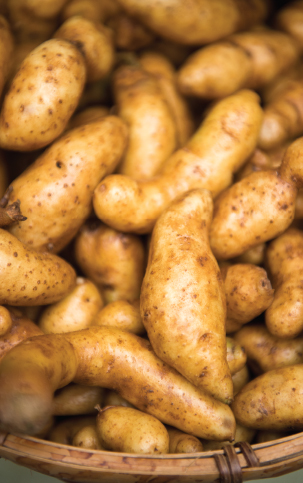GEAR
I DON’T USE ANY SPECIALTY TOOLS WHEN COOKING with the exception of paella pans and a food mill for mashed potatoes. You probably already have everything below, but if not, stop by a store to pick up whatever you’re missing to be able to cook everything from this book.
Cast-Iron Skillet: The one pan I turn to most is my well-seasoned 14-inch cast-iron skillet passed down to me from my grandmother. Get one big cast-iron skillet, season it well, and keep it seasoned. Cast-iron heats the most evenly and lasts for generations.
Heavy Skillets: Keep at least one large, heavy skillet, either copper or aluminum-clad, on hand for searing.
Nonstick Skillet: The only surefire way to flip a tortilla (here) is by using a nonstick skillet.
Dutch Oven: Get at least one large, deep enameled cast-iron Dutch oven with a lid for braises and stews.
Stockpots and Saucepans: You’ll need large ones with lids for soups and stews and for boiling ingredients from potatoes to octopus.
Paella Pan: If you’re committed to making paella, invest in a good paella pan and season it well. I like the ones from Pata Negra.
Half-Sheet Pans: Buy heavy commercial ones. They’ll last you a long time and can be used for everything from baking cakes to roasting vegetables to holding ingredients.
Bakeware: If you plan on trying my desserts (here), you’ll need a variety of baking dishes, as well as an ice cream maker.
Food Processor: I use a large Cuisinart for occasional chopping and slicing, as well as for making mayonnaise (here) and Allioli.
Blender: I prefer the power of a Vitamix blender. You can buy a blender in department stores, big box stores, and other kitchenware stores. It creates the creamiest and smoothest soups.
Sharp Knives: I rely on a chef’s knife most often, but I use a paring knife for smaller vegetables sometimes. A bread knife comes in handy anytime you need to slice a loaf.
Peeler: This is essential for most vegetables, and is ideal for preparing strips of citrus peels for cocktails.
Microplane Zester: I keep mine handy for zesting citrus.
Box Grater: The large holes work well for grating tomatoes, and the smaller holes for hard cheeses.
Can Opener: Some of Spain’s greatest ingredients come in cans. Be ready to open them.
Silicone Spatulas: I use the flat ones for scraping bowls clean and the offset one for removing fried eggs from pans.
Wooden Spoons: These are my go-to stirrers for the stovetop.
Measuring Cups, Spoons, and a Kitchen Scale: Precision is key to nailing any of these recipes. While you should season dishes to taste, start by making them exactly as written, measuring according to the specifications in the ingredient list.

JUST A LITTLE NOTE ON FOOD SAFETY
At my restaurant, I uphold the highest health standards for everything coming out of my kitchen. Any time I’m handling raw chicken or other meat, I wash my hands repeatedly and vigorously sanitize every surface around me. But I always let diners know that I do prefer to cook some things differently from what the U.S. Department of Agriculture (USDA) recommends and that anyone with a compromised immune system should take heed. For example, there are few things I enjoy more than a runny egg yolk and few things I like less than tough, overcooked meat and fish. But the USDA suggests you cook yolks through and meats and fish to temperatures I would consider overdone. Along the same lines, many Spanish dishes are served at room temperature. The USDA maintains guidelines on how long different foods should be kept at different temperatures. For detailed information on all of the above, you can read the relevant materials on usda.gov.


